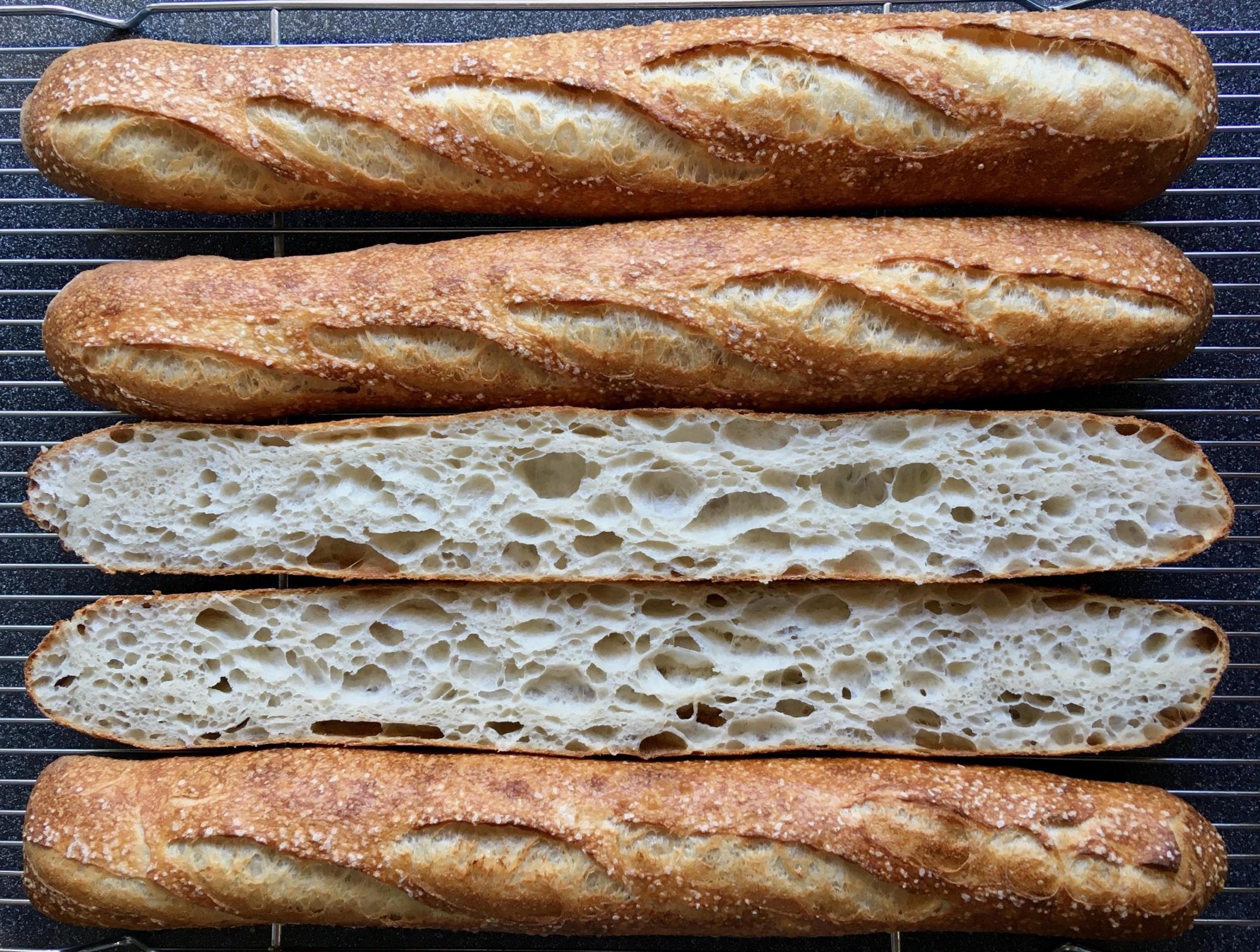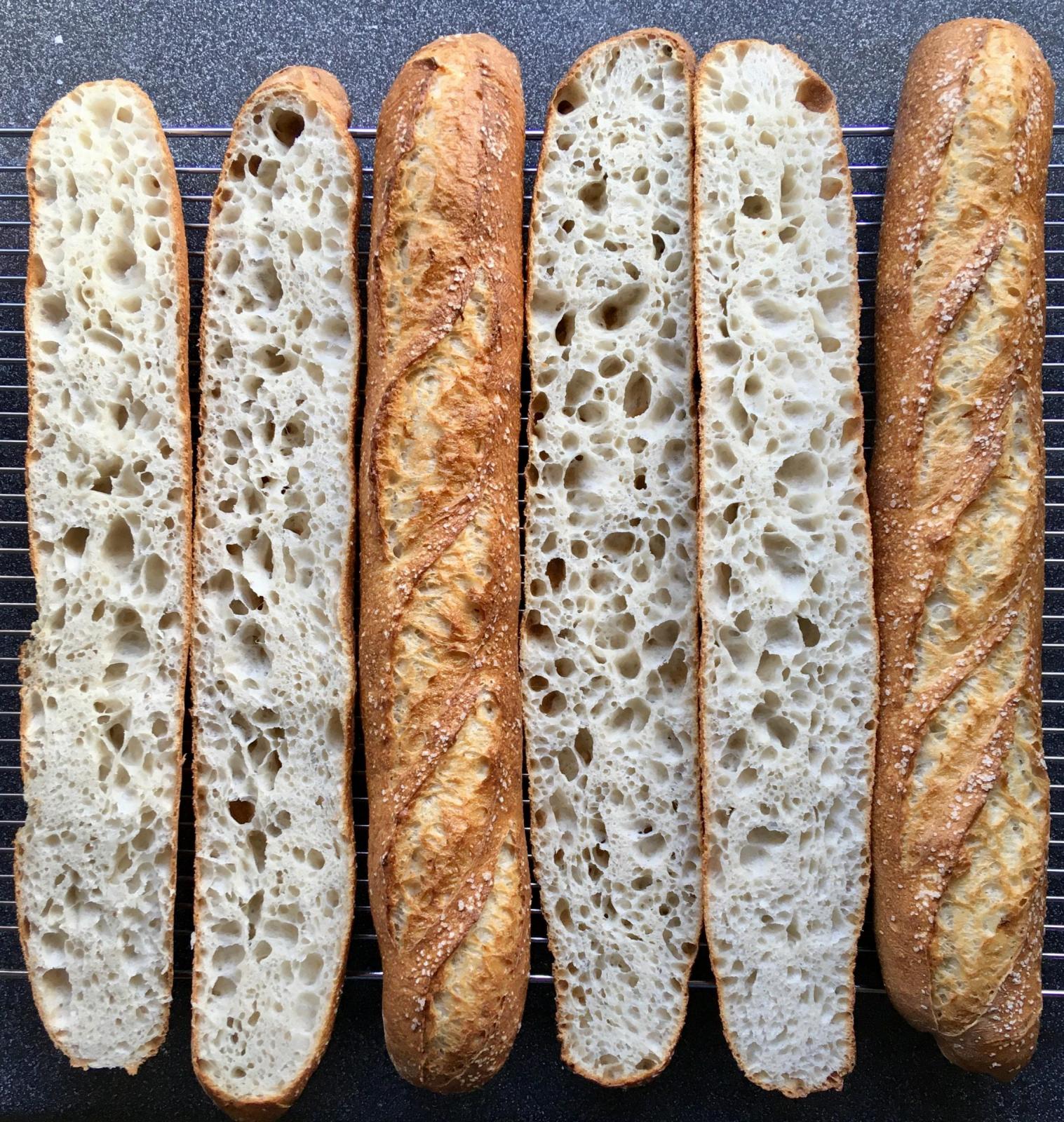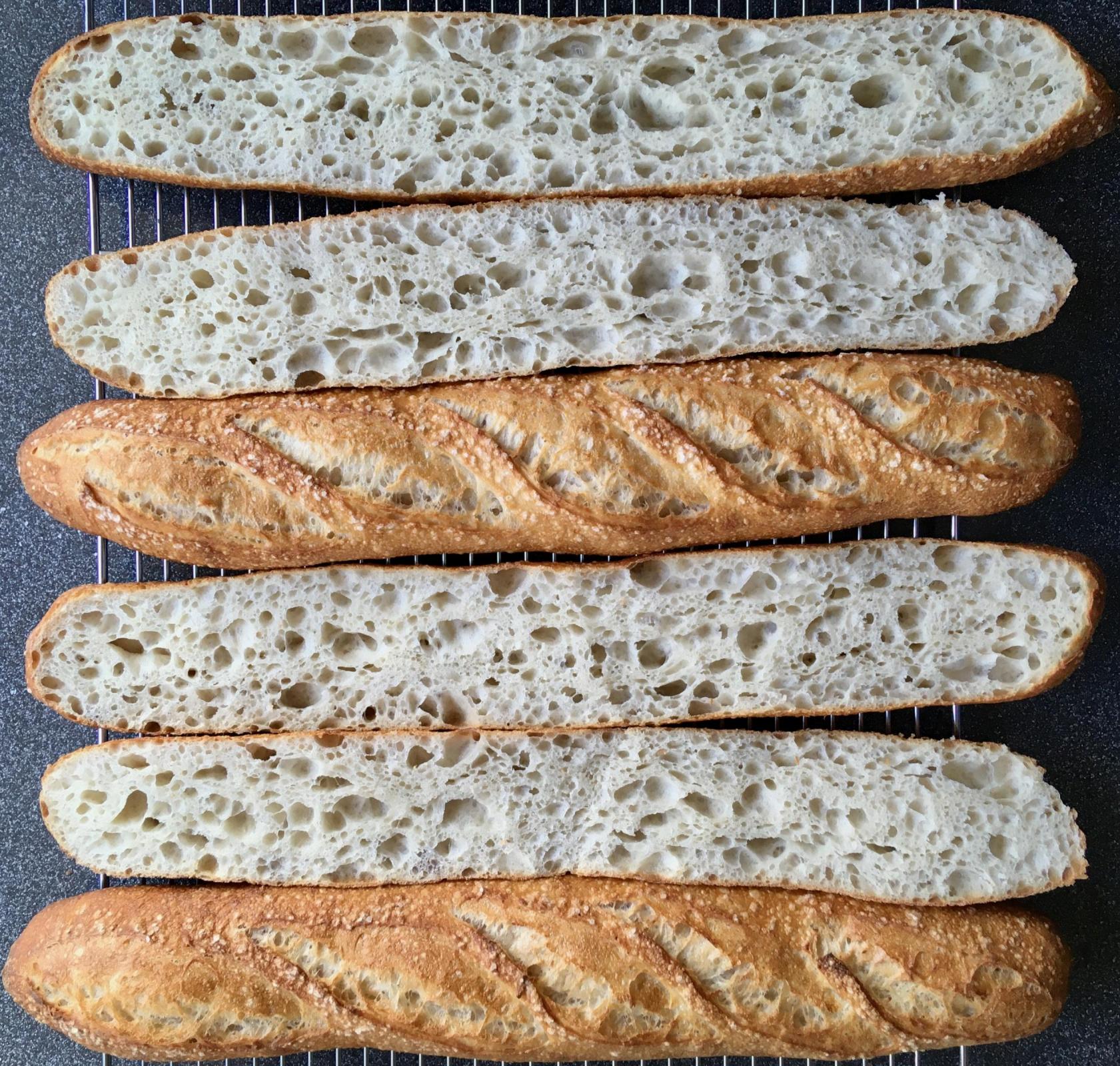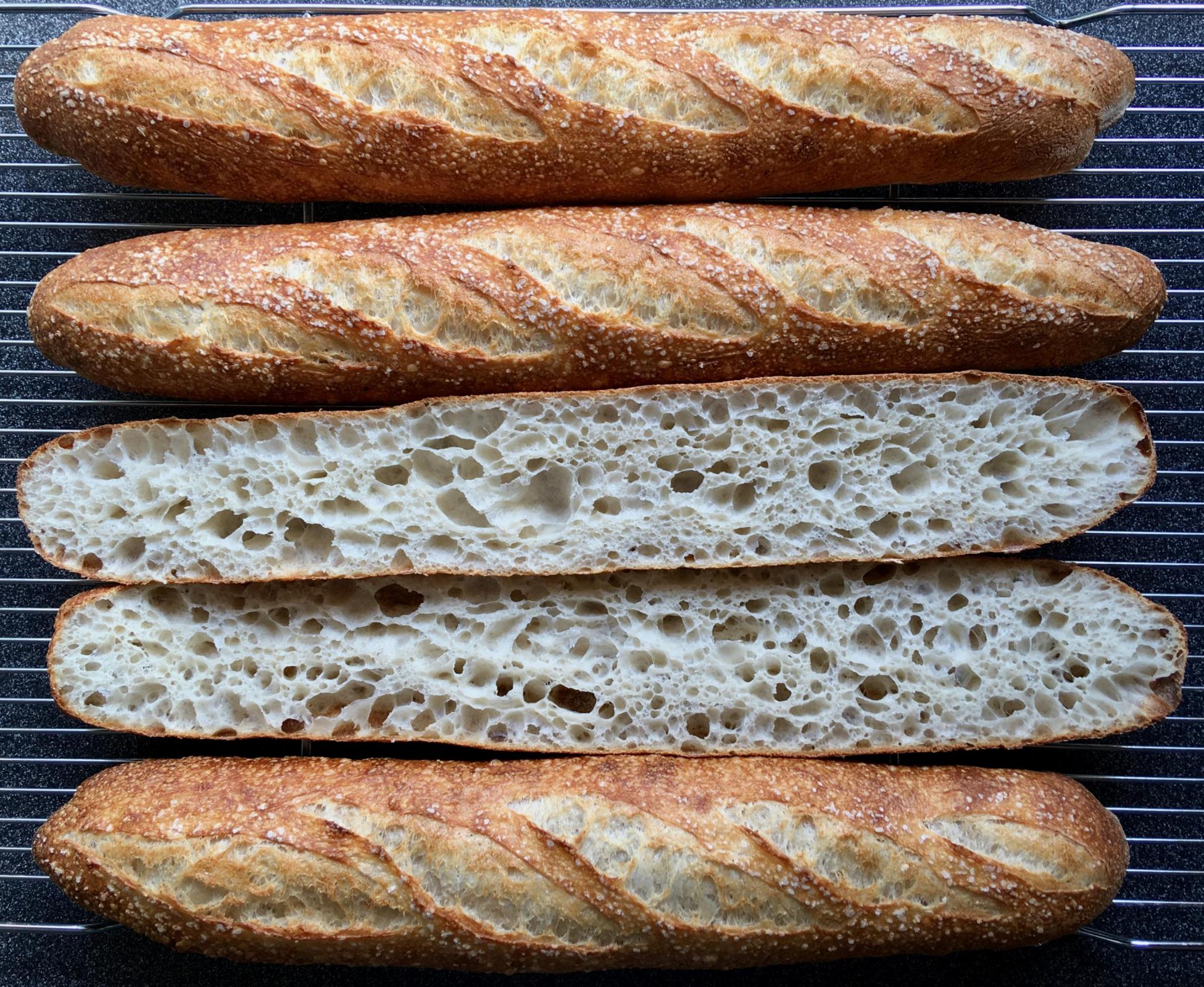In reviewing a few month's worth of baguettes, I found that a batch from 9/21/20 that had a nice open crumb and an unusually long and high energy mix. It was made with high gluten flour, 68% hydration, long mix time (5 min @speed 0 [low speed], 18 min @4 [high speed]), and 78.6°F dough temperature at end of mix.
9/21/20 (high gluten flour, 68% hydration)

To explore the territory, a test sequence was designed to bake three batches, with two (10/18/20 and 10/19/20) using AP flour at 66% and 68% hydration respectively, and one (10/21/20) using high gluten flour at 75% hydration.
10/18/20 (AP flour, 66% hydration)

10/19/20 (AP flour, 68% hydration)

10/21/20 (high gluten flour, 75% hydration)

The low protein flour and lower (66%) hydration responded well to the long mix times and yielded a reasonably open crumb. Slightly increasing the hydration (to 68%) did produce a slightly more open crumb, and presented some minor handling issues which were accommodated. While the high gluten flour with a bigger jump in hydration (to 75%) produced an even more open crumb (in keeping with the expectation that higher hydration should open up the crumb if everything else is equal) but at a cost in terms of ease of handling.
Mixing:
All of these were mixed in a Famag IM-5S with an initial stage (10 min) of mixing at speed 0 to combine the cold autolysed dough with the 12% pre-fermented flour in the levain, followed by 2 minute increments of mixing at speed 4 with total times at speed 4 of 10, 12 and 12 minutes respectively. Final dough temperatures were 78.8°, 79.1°, and 80.1°F.
It is important to note that every flour has an optimum level of hydration which varies depending on what you are making. Low protein flours require a lower hydration to deliver the same open crumb that you get using a high gluten flour and higher hydration. I found a technical paper (which I can't find at the moment) that approximated the optimum hydration as a linear function of the protein content, but the data points had a significant scatter pointing out that there are other factors in play and hydration is not the exclusive determinant of how open the crumb will be for a particular flour. This insight pushed me to experiment with much lower hydrations when using AP flour to make baguettes with surprizingly good results.
So the conclusion seems to be that you can get an open crumb baguette using either high gluten flour or AP flour when you use high intensity mixing for an extended period of time and enhance the open crumb even further when you add more water via bassinage after gluten development.
- Doc.Dough's Blog
- Log in or register to post comments
All these baguettes are impressive for their open crumb. Thanks for the additional knowledge on achieving open crumb with a higher protein flour. I don't typically use a mixer so I guess I'll continue to hand mix and use my lower protein flour.
Beautiful and thanks for sharing! I'd love to give this a try....can you tell us about your steaming method?
I have a small combi oven (in this case it is a Rational CPC-61 oven - with a Henny Penny brand on it so it is an LCS-6). It allows me to control the temperature and fan speed and box humidity independently. The CPC-61 model is out of production but there is a comparable model available from Rational (Henny Penny now has there own line of combi ovens and no longer sells the Rational product).
Ohhh, nice! It sounds like a professional level oven? Lucky you!
Doc, it is interesting that you are using what would generally be considered an intensive mix, yet producing an open crumb. Presumably your speed 4 approximates to what is normally known as speed 2 or high speed on a spiral mixer, ie 200rpm? (Aside: I find these infinitely variable spiral mixer variable speed drives a bit of a curse, because they make comparisons difficult and really, only 2 speeds are needed - 100 & 200rpm)
Yet we read in all the text books that an intensive mix will give a tight close crumb. Perhaps baguettes behave differently because of their unique shape and high surface area to volume ratio?
It would be interesting to shape some of that dough into a batard and see how it comes out.
Lance
Lance, Doc and I were talking about this. My impression on what the intensive mix is doing is making a high protein flour behave more like a lower protein flour by damaging some of the gluten network. For baguettes we found generally in the CB that lower protein flour was better for some of the requirements for baguettes in particular stretching while rolling out to final length. A dough that is too elastic will snap back and lose some of its stretched length. My take on his intensive mixing is that some of the gluten is damaged enough that a high protein flour will lose some of its elasticity and that benefits baguette shaping and crumb. Doc please correct me or add to this since this was your experiment.
Benny
Thanks Benny, that makes some sense now.
Lance
I hope Doc will chime in and correct any of my assessments, he would be far more knowledgeable than I am.
Benny - I suspect that you are right in that the net effect is to increase the extensibility and reduce the elasticity (for the mechanical engineers in the croud that is to increase the strain at rupture and decrease tensile strength). It might be thought of as allowing the gluten development to run past the point where it has maximum strength and it begins to actually tear without having the capacity to anneal. I think this means that the glutenin side chains are saturated and cannot continue to break and re-form bonds, they just break and stay broken.
Today I am running a batch with high gluten flour and 70% hydration, 12% PFF, 2% salt, 0.1% IDY, cold 10 hr autolyse without salt or levain but with the IDY in the mix. This does produce a very small amount of volume growth overnight (<5%) but the yeast is ready to contribute to the fermentation as soon as the dough warms up during mixing. It goes from a starting temperature of around 39°F, to 79°F with 10 minutes of slow mixing (100 RPM) followed by another 12 minutes in 6 - 2 minute increments at high speed (200 RPM). This is where there is a difference between long slow mixing and an equally long but higher speed mixing stage.
I use dough temperature as a metric to track where I am in the process. After the end of the slow mixing stage the dough is at ~64.5°F or about a 25°F temperature rise. The next 12 minutes includes bassinage of ~53g of water into the dough and a further temperature rise of ~15°F, so the reduced viscosity due to gluten breakdown, water addition, or temperature elevation results in a lower rate of addition of energy to the dough than was occuring at low temperature and low speed.
In watching it mix, there are two things I see, one seems to be a softening of the dough as it warms up and the other is the increase in extensibility which has the same manifestitation. I don't know how to differentiate at that stage. The dough just gets sort of pasty (you have already mixed it well past its maximum height and while it still pulls off the side of the mixer bowl cleanly it is also sticky).
When you then transfer it to the (Cambro/polypropylene) bulk fermentation container and fold it a couple of times, it gets back some structure and sits pretty high and does not just slump back onto the bottom of the container. Even after it has expanded by the agreed-to target of 25% (about 2:10 from start of mixing) for terminating BF and dividing, it still holds some shape and is easily pre-shaped into 8" cylinders that weigh ~440g.
Dividing it up is easy, though the dough is tacky while still pulling cleanly off the bench scraper.
There are big bubbles in the dough when it is pre-shaped so the prior observation that crumb openness is determined by things you do before the end of bulk fermentation seems to hold even when the dough is over-mixed to some extent.
For exactly the reason you point out, I use speed 0 (100 RPM) and speed 4 (200 RPM). Beyond that it is all done with timing.
When I get to baking ciabatta again, the form is an unshaped batard and you will see the effect. As I remember they just blow up like blimps and the challenge is mostly to learn how to handle very wet dough.
Nice display of the affects of additional water. I suppose that the intensive mixing would allow for even more water to be added and despite the difficult handling you should go north of 75% to see where the limits are. I have always wondered why you chose are larger dough amount for your baguettes?
I found that with my oven there is a minimum diameter required to get an ear, since at baguette diameters smaller than about 2.5", there is insufficient oven spring to break open the slash. You can go somewhat smaller when you use some IDY as I do here, but my process is tuned for 440g baguettes and I choose to hold that constant rather than having to compensate for being potentially different on each batch.
As for going above 75% hydration, that is ciabatta territory since getting a decent ear is almost impossible. But heading off in that direction is on my list of things to do. I used to bake ciabatta every week and I have not tried since I took delivery of the Famag mixer. So soon.
This is the fourth bake in the series, exploring a less aggressive hydration (70%) and getting an even more open crumb using an extended mix time (22 min in this case; 10 min @ low speed + 12 min @ high speed).
Again using a cold overnight autolyse that included flour, water, 0.1% IDY, 1% diastatic malt, but no salt or levain. A little over ~7% of the total water was withheld until after gluten development and then incorporated via bassinage. The levain (100% hydration) contained 12% of the total flour. The salt (2%) was incorporated after the levain and the autolysed flour were thoroughly mixed and the gluten partially developed. Dough temperature at the end of the 22 min mixing time was 79.2°F.
The dough was tacky when divided, but relatively easy to pre-shape. I followed Benny's suggestion to not press too firmly with the finger tips when pre-shaping to avoid the generation of void-free strips of dough in the crumb. If the dough is allowed to be sticky (or at least not have much flour on top) when transferred to the shaping mat this works quite well. The resulting dough pieces were quite extensible at final shaping after a 35 min rest. All baguettes rolled out to the 21" final length without any interim rest stages.
Final proof was 1:10 at room temperature followed by retarding for a few hours at 40°F for timing and to firm up the baguettes before slashing and baking.
That is a gorgeous crumb Doc. Tell me, how hard would it be to incorporate your 100% levain into the dough when it would have such low hydration such that the final dough has only 70% hydration. I ask this because I tried to add an autolyse one time and had a very hard time because so much of the dough’s water was in the levain it was really hard to hand mix thoroughly, at least that was my recollection.
At the moment my most recent bakes I’m doing some cheating and in fact do an all in one mix salt, water levain flour the works. Now with all this talk on the site about the benefits of autolyse I’m thinking that maybe I need to adjust the hydration of the levain to make the dough and that way I’d be able to do a proper autolyse or at minimum a saltolyse.
It can be a little bit of a challenge to design a process that works. My general guideline is that the autolyse needs to be wet enough to fully hydrate the flour. That means 58% or higher for me, and even at 58% it is work to get everything wet and smooth. Note that I do not believe that shaggy is a useful starting point for an autolyse. But I also currently believe that the only useful function of the autolyse is to fully hydrate the flour (subject to a new experiment that demonstrates something else). My hypothesis is that there are two kinds of starch in the flour - broken starch grains and un-broken starch grains; and they each have different water absorbtion profiles. The broken starch is what is attacked by the amylase enzymes to produce maltose.
For any dough that has a hydration north of 60%, I mix the autolyse at 60% and run the levain build to include the remaining water unless the resulting levain hydration would otherwise be greater than 100% - which will drive the use of a bassinage step to get the remaining water into the dough after the gluten is developed.
So the 70% hydration dough had the autolyse run at 60%, the levain at 100%, and the remaining 53g of water went into the bassinage step.
I do a refrigerated autolyse overnight that includes the flour, 60% water, any diastatic malt, and any IDY. All pre-mixed to a homogenous and smooth consistency (typically 7-8 minutes on low speed in the spiral mixer followed by a few turns on the bench to get everything smooth).
In parallel with the autolyse I grow the levain (typical mix is 28 + X + X where numbers are in grams and X is water and flour and may range from ~100g to 250g depending on the amount I need). The levain is grown in a warm place at ~84°F (±5° depending on weather and other factors)
After ~10 hrs the levain is checked to make sure that it has lost at least 2% of the weight of the added flour that was used to mix it (that would be 2 to 4g for 100-200g of flour). This is a highly accurate measure of levain maturity.
I now have cold autolysed flour/water/DM/IDY mix and warm levain. They are combined for about 10 minutes on low speed to thoroughly mix them and incorporate the salt. At that point the mixing speed is stepped up to high and the gluten is developed in 2 minute mixing increments, monitoring the dough temperature after each step. After 6 or 8 minutes I incorporate any residual water via bassinage (I find that it goes in slowly and if you try to make it go fast, the dough will just break and until it comes back together you are making no progress so I find that I can get it to absorb perhaps 20-30g per minute of mixing time without breaking.
After the last bit of water is incorporated, the dough is mixed until I am satisfied with the extensibility and strength (currently that means that the dough temperature reaches ~79°F).
When I was working at dough hydrations in the high 50's, the levain had to have the same hydration as the autolysed flour in order to make it work and that meant that the levain fermentation time was somewhat longer (though the 2% weight loss still turned out to be an excellent end point).
Hope this helps.
Thanks for your detailed write-up, Doc; it's good to have a few more spiral mixer owners here and to be able to compare notes.
I've always steered clear of long autolyses after one or two early trials when they were all the rage and I ended up with soup. Of course if you are doing them cold (and some add salt too), then that's a different kettle of fish.
But I do think I would struggle to get a decent dough temperature if the bulk of the mix had been sitting at 40F overnight.
Lance
10/25/20: AP flour, 0.1% IDY in cold overnight autolyse @ 60% hydration, 120% BF, 35 min rest, 4 x 440g baguettes +
PFF levain hydration dough hydration salt total batch size
12.1% 100% 68% 2.0% 1800 (includes 30g for aliquot jar)
mix 262g levain (28 seed + 117 H2O + 117 BF) + 560 H2O + 33 bassinage + 922 AP + 10 diastatic malt + 1.04g IDY + 21.20 salt
Process: combine the 922 AP flour, 10g diastatic malt, 0.1% IDY (1g) and 560 cold water and mix for 8 min at speed 0 Knead a few turns until it is fully smooth and cover bowl with StretchTite and refrigerate overnight.
Autolysed dough 1486g@°F
Add 258g net levain mix @0 for 5 min
55.3°F after 5 min at speed 0 (Incorporate the salt during the last 2 min at speed 0)
61.7°F 10 min @0 This just mixes the levain with the autolysed flour/water/yeast/DM
Switch to speed 4
65.7°F 2min@4
69.2°F 4min@4
71.6°F 6min@4
73.7°F 8 min@4 (including bassinage 31g of water)
75.3°F 10 min@4 quit because the dough is getting stringy
[trying to over-develop the gluten and get the effect of using a lower protein flour]
Take 30g for aliquot jar Ferment to ~120% of original volume (48 ml on aliquot jar)(2:20 from start of mixing)
Divide into 4 parts (4x ~440g ) and pre-shape (5 min),.
Cut dough into rectangles, pre-shaped per Abel and rest 35min, final shape (7 min)
Counter proof for 1:15
Proofed until Aliquot jar =70ml [this continues to be a reasonable signal for end of counter proof]
Retard >1:15 @40°F to make it easier to slash Bake using BAG-STM2 oven cycle
Assessment:
This batch seemed really soupy in the mixing bowl and I stopped mixing after 20 minutes rather than continuing up to 79°F dough temp
With three sets of folds as soon as the dough went into the BF container it felt better and no further folds were performed.
Dough was still somewhat sticky when it was divided but it was fairly easy to cut and it was quite easy to pre-shape and final shape.
Again this dough took 1:15 of final proofing on the bench followed by a couple of hours to chill and stiffen up before baking. You can see that one cut baguette has a somewhat more open crumb than the other so there is still work to do to further improve my shaping skills.
First four baguettes because I thought the color and contrast of these was very nice with lots of oven spring:
And then a cut-away crumb shot
And below an ear shot where you can see the somewhat darker crust with no discernable blisters but with nice ears. I was a little surprised by the pronounced ears on a batch that was relatively wet for an AP flour (68%) especially given the almost insignificant ears on the batch a couple of days ago made with high gluten flour at 75% hydration. The crust was crispy, the crumb tender, and the flavor very good. The new flour is the Smart & Final 1st Street AP which I have not used before and since it was on sale I picked up two bags for experimentation.
Fantastic bake Doc. Love the crumb and crust along with the great ears. I too have been using the aliquot jar with the dough through cold retard and then during room temperature final proof to monitor dough expansion. If I understand correctly you end final proof when the aliquot jar is at 200% of original size? If that is correct, I’ve never tried final proofing for that long.
Aliquot jar water level starts at 42ml (30 + 10 + 2 to account for the IDY contribution during cold autolyse) and end of counter proof is right around 70% so 28/32 which is not quite 100% volume increase. There is alway a tactile test to make sure it feels right too.
Yes I also do a poke test as well, but I've never waited until a 100% volume increase, I may have to experiment a bit. Now with much cooler temperatures that might entail quite a long bench rest.
I miss a lot of BLOG post because they don’t pop up in the Recent Comments column.
Great post! I will be carefully reading the OP and all of the replies. This information is extremely interesting.
Thanks for posting it.